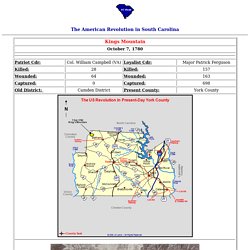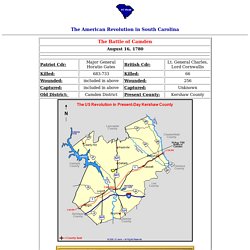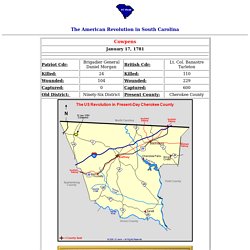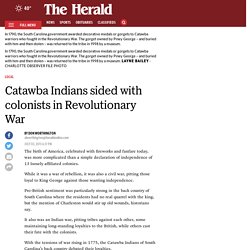

Mrs. Nees
Curriculum Standards Search for 8.3.3. Weaknesses of the Articles of Confederation (Video 4:30) Constitution Teacher Board-Federalists and Anti-Federalists. Anti-Federalists Bill of Rights Video 3:00 minutes. Images and copyright. PKMS Station 1 databases. Wikimedia. Google Advanced Image Search. SC Battles and Skirmishes - American Revolution. The Siege of Charlestown. Major General Benjamin Lincoln - Commander SC Continental Brigade led by Brigadier General William Moultrie, Lt.

Col. William Massey - Deputy QM General. Major Andrew Dellient, Capt. Richard Beresford (Aide-de-Camp) SC 1st Regiment led by Col. Pulaski's Legion of Infantry led by Major Chevalier Pierre-Francois Vernier with the following four (4) known companies, led by: - Capt. SC 2nd Regiment led by Lt. SC 3rd Regiment (Rangers) led by Lt. NC Continental Brigade led by Brigadier General James Hogun with the following three (3) known regiments: 1st NC Regiment led by Col. 2nd NC Regiment led by Col. 3rd NC Regiment led by Lt. The Battle of Kings Mountain. Major Patrick Ferguson was patrolling with a force of about 125 Provincials and over 1,000 Loyalist supporters attempting to pacify the countryside.

With violence and atrocities rising on both sides, 1,100 to 1,600 Patriot Militiamen, most from North Carolina but with a good number of Virginians and South Carolinians, gathered to stop Major Ferguson and his troops. When Major Ferguson became aware of the large contingent of Patriots gathering, he decided it would be prudent to move back toward Lord Cornwallis's larger army, now in Charlotte, North Carolina, a little over 40 miles to the east. The Patriot Militia followed rapidly and, when Major Ferguson realized that they were overtaking him, he organized his defenses atop Kings Mountain, a wooded hill with a fairly clear top. On October 7, 1780, the Patriot Militia arrived at the base of the mountain and surrounded it. Soon they began scaling it on all sides. The Battle of Camden. Major General Horatio Gates - Commanding Officer Continental Forces led by Major General Johann-Alexandre von Robaii, Baron DeKalb in the following units: MD 1st Brigade led by Brigadier General William Smallwood with 400 men in the following units:

The Battle of Eutaw Springs. The Battle of Cowpens. Brigadier General Daniel Morgan - Commanding Officer MD-DE Light Infantry Battalion led by Lt.

Col. John Eager Howard with the following units: - Delaware Company - Capt. Robert H. Kirkwood with 63 men - 1st Maryland Company - Capt. Opposing viewpoints about about Battle of Kings Mountain. Offical Website Battle of Camden. Catawba Indians sided with colonists in Revolutionary War. The birth of America, celebrated with fireworks and fanfare today, was more complicated than a simple declaration of independence of 13 loosely affiliated colonies.

While it was a war of rebellion, it was also a civil war, pitting those loyal to King George against those wanting independence. Pro-British sentiment was particularly strong in the back country of South Carolina where the residents had no real quarrel with the king, but the mention of Charleston would stir up old wounds, historians say. It also was an Indian war, pitting tribes against each other, some maintaining long-standing loyalties to the British, while others cast their fate with the colonists. With the tensions of war rising in 1775, the Catawba Indians of South Carolina’s back country debated their loyalties.
Many Catawba warriors had fought with the British in the French and Indian War, battling the French and other Indians. They wanted answers, but not verbally. As a result, says historian James H. In battle Fort Mill. Siege of Charleston was key Revolutionary War battle. For six weeks, the city held off enemy troops, fighting the longest siege of the war to preserve the freedom of a newly founded nation.

Now, thousands of people walk the site every day without even realizing it is a battlefield -- the largest in South Carolina -- or the role it played in the holiday the country celebrates today. "I'm always amazed when I give tours that people don't realize there was a major battle here in 1780," said Carl Borick, assistant director of the Charleston Museum and author of "A Gallant Defense: The Siege of Charleston, 1780. "The siege is important. It was the largest battle in South Carolina during the Revolutionary War.
" Today almost nothing remains to remind folks of that struggle, save for a bit of tabby unearthed on Marion Square. That may be because its status is "paved. " More than 230 years ago, what is now John Street was a moat, a blocked tidal creek of the Cooper River that penetrated deep into the peninsula. Civil War Trust.